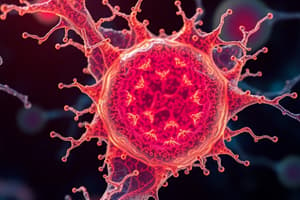Podcast
Questions and Answers
In 1665, British scientist Robert Hooke discovered cells using a crude ______.
In 1665, British scientist Robert Hooke discovered cells using a crude ______.
microscope
The basic unit of life is called a ______.
The basic unit of life is called a ______.
cell
All living organisms are composed of ______.
All living organisms are composed of ______.
cells
Rudolf Virchow introduced the postulate that new cells are created from ______ cells.
Rudolf Virchow introduced the postulate that new cells are created from ______ cells.
The first sight of cells by humans happened in the late 1600s when Anton van Leeuwenhoek examined ______ subjects.
The first sight of cells by humans happened in the late 1600s when Anton van Leeuwenhoek examined ______ subjects.
The archaic theory of spontaneous generation was disproved, which promoted the concept that living things generated from ______ matter.
The archaic theory of spontaneous generation was disproved, which promoted the concept that living things generated from ______ matter.
Robert Hooke viewed a thin slice of cork and found hollow, small structures that reminded him of ______.
Robert Hooke viewed a thin slice of cork and found hollow, small structures that reminded him of ______.
Matthias Schleiden microscopically examined plants and proposed that different structures of a plant are all composed of ______.
Matthias Schleiden microscopically examined plants and proposed that different structures of a plant are all composed of ______.
Louis Pasteur proved that bacteria can multiply and that bacteria's cells come from other ______ cells.
Louis Pasteur proved that bacteria can multiply and that bacteria's cells come from other ______ cells.
Rudolf Virchow declared, '______ cellula e cellula' to complete the cell theory.
Rudolf Virchow declared, '______ cellula e cellula' to complete the cell theory.
Flashcards are hidden until you start studying
Study Notes
Discovery of Cells
- In 1665, Robert Hooke examined cork using a crude microscope, observing structures he called "cellulae" or "little rooms."
- Anton van Leeuwenhoek advanced microscopy in the late 1600s, discovering moving protists, which he termed "animalcules."
Cell Theory Development
- Formulated in the mid-1800s, Cell Theory consists of three fundamental postulates:
- The cell is the basic unit of life.
- All living organisms consist of cells.
- New cells arise from preexisting cells.
First Postulate
- The cell is essential for life; living organisms may be unicellular (like bacteria) or multicellular (like animals).
Second Postulate
- Matthias Schleiden contributed to the understanding of plant cells, correlating them with Robert Brown's discovery of the nucleus.
- Theodor Schwann studied animal cells, concluding they too are made of cells, further solidifying the postulate.
Third Postulate
- Rudolf Virchow introduced the idea that "Omnis cellula e cellula" signifies that new cells arise from existing cells.
- This principle superseded the outdated belief in spontaneous generation.
Historical Timeline of Cell Theory
- 1590: Zacharias Janssen invented the primitive microscope with his father, paving the way for future microscopic studies.
- 1663-1665: Hooke studied cork with Janssen's microscope, identifying hollow structures resembling cellulae.
- 1665-1676: Marcello Malpighi and Nehemiah Grew independently documented organelles in plant cells.
- 1670-1683: Leeuwenhoek enhanced Janssen's microscope, achieving magnifications of up to 270x.
- 1831: Robert Brown discovered the nucleus, contributing significantly to cell organelle understanding.
- 1838: Schleiden proposed that all parts of plants are composed of cells through microscopic examination.
- 1839: Schwann, influenced by Schleiden, asserted that animals are also cellular in composition.
- 1840: Albrecht von Roelliker noted sperm and egg are cellular, establishing that all humans derive from cells.
- 1849: Louis Pasteur demonstrated that bacteria multiply from other bacterial cells during his fermentation studies.
- 1858: Virchow, synthesizing various scientific findings, declared "Omnis cellula e cellula," completing the Cell Theory.
Studying That Suits You
Use AI to generate personalized quizzes and flashcards to suit your learning preferences.



